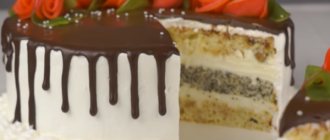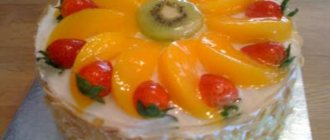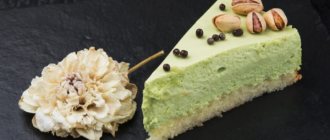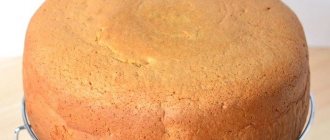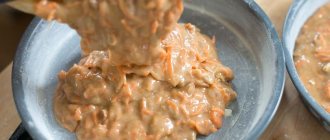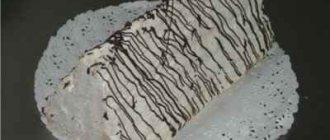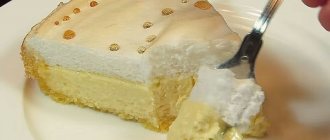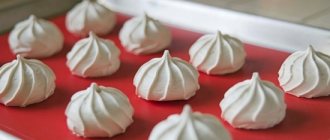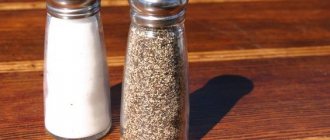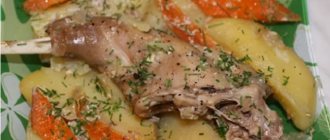How to make homemade Pancho cake:
We are preparing a sponge cake for Pancho cake, we will measure everything with a 250 ml cup.
1. Measure out 2.5 cups of flour. Add 11 grams of baking powder for dough and mix.
2. Take 4 medium or 5 small chicken eggs. Beat with a mixer.
3. Then gradually, little by little, add 2 cups of sugar. After adding sugar, beat the mixture for another 4 minutes.
4. Add one cup of milk and stir.
5. Add a cup of any refined vegetable oil (without strong taste or smell), stir.
6. Add the previously prepared flour and baking powder. This must be done quickly, but so that the dough turns out homogeneous, without lumps of flour.
7. Take a deep baking tray and line it with baking paper. We place a deep plate under one edge to raise it. And pour the dough onto the bottom half.
8. Add a tablespoon of cocoa to the remaining half of the dough. Stir quickly and pour onto the baking sheet from the other side.
You can also use cake pans for baking.
9. Bake the biscuit in an oven preheated to 180°C. Approximately 50 minutes.
We do not open the oven for the first 30 minutes, and then check the readiness of the biscuit using a toothpick. If, when you insert a toothpick into the center, it comes out dry, then the sponge cake is baked enough.
10. Let the biscuit cool down completely for 2-3 hours. Then carefully remove the baking paper.
11. We cut out the base for the cake in the center of the sponge cake so that it turns out to be two colors.
12. This is not necessary, but we will make the cake base thinner. Cut it in half using dental floss.
13. Cut the remaining biscuit into small pieces.
Mary Wollstonecraft (27 April 1759 – 10 September 1797)
- British writer, philosopher and feminist of the 18th century. Author of novels, treatises, a collection of letters, a book about the history of the Great French Revolution, a book about education and a children's book. Wollstonecraft is famous for her essay A Vindication of the Rights of Woman (1792), in which she argues that women are not inferior beings to men, but appear so because of lack of education. She proposes to consider both men and women as rational beings and imagines a social order based on reason.
Among the general public and especially among feminists, the events of Wollstonecraft's personal life became more widely known than her works because of their unusualness and sometimes scandalousness. After two unsuccessful romances with Henry Fuseli and Gilbert Imlay, Wollstonecraft married William Godwin, a philosopher and forerunner of the anarchist movement. Their daughter Mary Shelley is known as the author of the novel Frankenstein. Wollstonecraft died at thirty-eight from puerperal fever, leaving behind several unfinished manuscripts.
After the death of the writer, Godwin in 1798 published memoirs about his wife, a woman without prejudice, which unwittingly damaged her reputation. However, with the rise of the feminist movement in the early 20th century, Wollstonecraft's views on women's rights and critique of typical notions of femininity became increasingly important. Today, Wollstonecraft is considered one of the first feminist philosophers, and her life and works have greatly influenced many feminists.
Wollstonecraft was born on April 27, 1759 in Spitalfields, London.
. Her father squandered the family's fortune in various speculations, and the Wollstonecrafts had to move frequently due to their difficult financial situation. Later, Mary was forced by her father to give up some of the money that she would have inherited upon reaching adulthood. In addition, the head of the family drank and often beat his wife. As a young girl, Mary would sleep next to her mother's bedroom door to protect her. Throughout her life, Mary had a strong influence on her sisters, Everina (Everaina) and Eliza. For example, in 1784, she convinced Eliza, who was suffering from postpartum depression, to leave her husband and baby. Disdaining generally accepted norms, Mary prepared everything so that her sister could escape. Such an act was unthinkable at that time: Eliza could no longer marry and, having lost all her means of livelihood, was forced to work for pennies.
Wollstonecraft's early life was marked by friendships with two women. The first was Jane Arden from Beverly. They often read books together and attended lectures by Arden's father, a self-taught philosopher. Wollstonecraft enjoyed the intellectual atmosphere of the Arden family, valued her friendship with Jane highly, and was even possessive of her friend. She wrote to Jane: “I have developed a romantic understanding of friendship... I am a little peculiar in my ideas about love and friendship; I must take first place or nothing.” Some letters clearly reveal the emotional instability and tendency towards depression that haunted Mary throughout her life.
Second and much more important was her friendship with Fanny Blood, which, as Mary Wollstonecraft claimed, helped broaden her horizons. Unhappy in her family life, Wollstonecraft left her parents' home in 1778 and became a companion to Sarah Dawson, a widow living in Bath. Wollstonecraft had a hard time in the service of a woman with a difficult character, but the experience gained later greatly helped in her work on “Thoughts on the Education of Daughters (English)” (1787).
In 1780, Mary returned home to care for her dying mother, and after her mother's death she left the service and went to the Bloods. During her two years with the Bloods, Wollstonecraft realized that she had idealized Fanny, who adhered to traditional feminine values. But Wollstonecraft always remained devoted to Fanny and her family.
With Blood, she dreamed of life in a “female utopia”: the girls planned to rent rooms together and support each other emotionally and financially, which, however, was not feasible due to lack of funds. To earn a living, Wollstonecraft, her sisters and Fanny Blood set up a school in Newington Green, a dissenter commune. Blood soon became engaged and, after marriage, her husband, Hugh Skase, took her to Europe for treatment. Despite this, Blood's health deteriorated further after her pregnancy. In 1785, Wollstonecraft left school and went to a friend to look after her, but Fanny soon died. After Mary left, the school in Newington Green closed. Blood's death had a profound impact on Wollstonecraft and inspired her first novel, Mary (1788).
After Blood's death, Wollstonecraft's friends helped her obtain a position as governess for the daughters of the Anglo-Irish Kingsborough family in Ireland. Wollstonecraft's relationship with Lady Kingsborough did not work out, but the girls adored their governess. Margaret King later said that Wollstonecraft "freed her from all prejudices." Impressions from working in the Kingsborough family were included in Wollstonecraft's only children's book, Original Stories from Reality (1788).
Disappointed with the limited choices open to women in contemporary society (reflections on this topic were reflected in the chapter of Thoughts on the Education of Daughters entitled “The Unfortunate Situation of Women Fashionably Educated and Left Without Wealth”), Mary left her job as a governess and began a career writers. This was a bold step, since at that time it was difficult for a woman to make a living as a writer. As Mary wrote to her sister Everaina in 1787, she was trying to become “the first of a new race.”
With the help of liberal publisher Joseph Johnson, Wollstonecraft found housing and work in London. Johnson himself became much more than just a friend for Mary - in her letters she called him father and brother. Having learned French and German, Wollstonecraft began translating, among which the most famous are “On the Importance of Religious Opinions” by Jacques Necker and “Elements of Ethics for the Use of Children” by Christian Gotthilf Salzmann. She also wrote reviews, mostly of novels, for Johnson's periodical, The Analytical Review. Her horizons expanded not only through the reading required for her work as a critic, but also through the people she met. Wollstonecraft attended Johnson's famous dinners, where she met radical pamphleteer Thomas Paine and philosopher William Godwin. After their first meeting, Godwin and Wollstonecraft were disappointed in each other: Godwin came to listen to Paine, but Wollstonecraft attacked him all evening, disagreeing on almost every issue.
In London, Wollstonecraft began a romantic relationship with the artist Henry Fusli. She wrote that she admired his genius, “the splendor of his soul, his lively mind and charm.” Füsli was married, and Wollstonecraft proposed a platonic tripartite alliance for him and his wife. Fusli's wife was shocked by this proposal, and Fusli himself ended all relations with Wollstonecraft. After the breakup, she left for France because she wanted to forget the unpleasant history, and, in addition, she wanted to take part in the revolutionary events glorified by her in her recent “Defense of the Rights of Man” (1790). This essay was written in response to the conservative critique of the French Revolution in Edmund Burke's Reflections on the French Revolution, and unexpectedly made the writer famous. She was compared to such leading literary figures as the theologian and preacher Joseph Priestley and Thomas Paine, whose book The Rights of Man (1791) proved to be the most popular response to Burke's attacks. Paine's ideas from The Rights of Man were developed in Wollstonecraft's most famous work, A Vindication of the Rights of Woman (1792).
France and Gilbert Imlay
In December 1792, Wollstonecraft arrived in Paris. Four months earlier, the monarchy in France was destroyed, the trial of Louis XVI began, and revolutionary terror unfolded in the country. Mary joined the circle of British subjects (among them Helen Mariah Williams) who were in the capital of France. Having just written A Vindication of the Rights of Woman, Wollstonecraft was determined to put her ideas into practice. She met the American adventurer Gilbert Imlay, in whose person she found the ideal hero. Having previously denied the sexual component of love relationships, she fell passionately in love with Imlay. On May 14, 1794, Mary gave birth to her first child, Fanny, named after her close friend. Wollstonecraft was overjoyed; she wrote to a friend: “My little girl is starting to suck so MANLY that her father is cheekily claiming that she will write the second part of The Rights of Women.” Despite everyday hardships and the dangers of revolutionary terror, Wollstonecraft continued to write actively. While in Le Havre in northern France, she wrote about the history of the early revolution in A Historical and Moral View of the French Revolution, published in London in December 1794.
Meanwhile, the political situation was deteriorating: Great Britain declared war on France, British citizens in France as subjects of a hostile country were in great danger. To protect Wollstonecraft from persecution, Imlay formally registered her as his wife in 1793. In fact, the marriage between them was never concluded. Many of Wollstonecraft's friends (including Thomas Paine) were arrested and some executed. Wollstonecraft's sisters were sure that she was imprisoned. Returning to England, Wollstonecraft continued to call herself “Mistress Imlay” even among her family, so that her daughter would not be considered illegitimate.
Imlay lost interest in Mary, who was completely absorbed in the house and her daughter, and soon left her. He promised to return to Le Havre, where Wollstonecraft had gone to give birth, but his long absence and rare letters in response to passionate appeals convinced Mary that Imlay was unfaithful. Letters to him at that time are full of persuasion and complaints, which most critics explain by the deep humiliation of women, and others by the surrounding situation: Wollstonecraft was left alone with a child in the center of revolutionary events.
England and William Godwin
In search of Imlay, Wollstonecraft returned to London in April 1795, but he finally broke off all relations with her. In May 1795, she attempted suicide, probably using tincture of opium, but Imlay saved her life (it is unclear how). Hoping to regain his affection, Wollstonecraft, alone, with her little daughter and a maid, traveled to Scandinavia to conduct business negotiations on Imlay’s behalf and improve his financial situation. She described her impressions in letters of reflection addressed to Imlay; Most of them were published in 1796 as a separate book, Letters Written in Sweden, Norway and Denmark. When Wollstonecraft returned to England and realized that her relationship with Imlay was over, she made a second suicide attempt, writing to him:
Let my grievances go with me! Soon, very soon, I will find peace. When you receive this letter, my hot head will be cold […] I will throw myself into the Thames, where no one can snatch me from the hands of death, which I so crave. God bless you! I wish you never experience what you made me experience. Someday your soul will awaken, repentance will find its way to your heart, and in the midst of your triumph I will appear before you, the victim of your deception.
On the rainy night before throwing herself into the Thames, she wandered the streets for a long time “to weigh down her clothes with water.” A random passer-by saved her. Wollstonecraft considered her suicide attempt not an act of despair, but a deliberate act: “I only have to lament that when the bitterness of death had passed, I was cruelly returned to life and suffering. But a strong intention cannot be upset by disappointment, and I will not allow what was one of the calmest actions of the mind to be considered a desperate attempt. In this regard, I am responsible only to myself. If I were worried about what is called reputation, it would be other circumstances that would dishonor me.”
After some time, Wollstonecraft returned to life, renewed connections with Joseph Johnson's circle, especially Mary Hayes, Elizabeth Inchbald, Sarah Siddons, William Godwin, and took up literature again. Gradually, the relationship between Godwin and Wollstonecraft grew into a passionate romance. Godwin read her Letters Written in Sweden, Norway and Denmark and later wrote: “If ever there was a book calculated to make a man fall in love with the author, this, it seems to me, is that book. She speaks of her sorrows in a way that fills us with melancholy and dissolves us in tenderness, while at the same time she shows genius, arousing our admiration.” They married on March 29, 1797 to legitimize the child Mary was expecting. It was then discovered that Wollstonecraft had never been married to Imlay. Because of this marriage, some of their acquaintances turned their backs on the Godwins. Many accused Godwin of inconsistency: in the philosophical treatise “Political Justice” he advocated the abolition of the institution of marriage, but in life he tied the knot. Each maintaining their independence, husband and wife lived in two adjacent houses known as the Polygon. The couple often exchanged letters. By all accounts, it was a happy and lasting, albeit tragically short, relationship.
Death and Memoirs of Godwin
On August 30, 1797, Wollstonecraft gave birth to her second daughter, Mary. Although the birth initially seemed normal, the mother developed an intrauterine infection (part of the placenta did not come out during labor and caused the onset of illness), which was common in the 18th century. On September 10, after several days of suffering, Wollstonecraft died of sepsisemia. Godwin was devastated: he wrote to friend Thomas Holcroft: “I firmly believe she has no equal in the world. I know from experience that we were created to make each other happy. I have no hope that I can ever know happiness again.” She was buried in the cemetery of the old church of St. Pancras, and a monument was erected to her there. Her and Godwin's remains were later moved to Bournemouth. The tombstone reads: "Mary Wollstonecraft Godwin, author of the essay A Vindication of the Rights of Woman: born April 27, 1759, died September 10, 1797."
In January 1798, Godwin published his Memoirs of the Author of a Vindication of the Rights of Woman. Although Godwin portrayed his wife with love, compassion, and sincerity, many readers were shocked by his revelations of Wollstonecraft's illegitimate children, affairs, and suicide attempts. The romantic poet Robert Southey accused him of "lack of feeling and of stripping his dead wife naked."
Godwin's Memoirs portray Wollstonecraft as a woman with a skeptical attitude toward religion (more than her writings would suggest); a person capable of experiencing deep feelings, ready for empathy and at the same time rational. Godwin's views on Wollstonecraft held sway throughout the 19th century and led to poems such as Robert Browning's "Wollstonecraft and Fusley" and William Roscoe's poem, which contains the following lines:
Hard was your fate in all the scenes of life
As daughter, sister, mother, friend, and wife;
But harder still, thy fate in death we own,
Thus mourn'd by Godwin with a heart of stone.
Heritage
According to historian Cora Kaplan, Wollstonecraft left a “strange” legacy: she was “an activist writer skilled in many genres,” but “until the last quarter of a century, Wollstonecraft’s life attracted greater interest than her work.” Under the influence of Godwin's Memoirs, a negative attitude towards Wollstonecraft was formed in society for a whole century. Mariah Edgeworth portrayed the writer as the “capricious” Harriet Frick in her novel Belinda (1801). Following her, other novelists: Mary Hayes, Charlotte Smith, Fanny Burney and Jane West, wanting to teach a “moral lesson” to their readers, created a number of similar characters. Wollstonecraft scholar Virginia Sapiro notes that very few people in the 19th century read or studied her works because the prevailing view was “that a woman with self-respect should not read [them].” One important exception was George Eliot, who wrote an essay on women's roles and rights in which she compared Wollstonecraft and Margaret Fuller, the American feminist.
When the modern feminist movement began, women as different in their political beliefs as Virginia Woolf and Emma Goldman drew attention to Wollstonecraft and expressed admiration for her “experiments in life” (Woolf's definition in a famous essay). Many, however, continued to condemn Wollstonecraft's lifestyle, and the significance of her works was still ignored.
It was only with the advent of scholarly feminist criticism in the 1960s and 1970s that Wollstonecraft's writings were finally recognized as fundamental to the issue. Their fate mirrored that of the feminist movement itself. In the early 1970s, six major biographies of Wollstonecraft were published, presenting her "passionate life as applied to her radical and rationalist intentions."
Historians have looked at Wollstock as a paradoxical yet intriguing figure, at odds with the 1970s version of feminism that linked personal life to political life. In the 1980s and 1990s, another concept of Wollstonecraft emerged, describing her as still a creature of her time. Scholars such as Claudia Johnson, Gary Kelly, and Virginia Sapiro have pointed out the connections between Wollstonecraft's thought and other important 18th-century ideas about the senses, economics, and political theory.
In recent years, Wollstonecraft's writings have influenced feminism outside of academia. Ayaan Hirsi Ali, a feminist critical of Muslim views of women, quoted the pamphlet "Woman's Rights" in her autobiography and wrote that she was "inspired by Mary Wollstonecraft, who was the first to reveal to women that they were capable of reasoning like men and deserved the same." right." Also noteworthy is the pro-life feminist movement, whose members cite Wollstonecraft's statements against induced abortion.
Sources:
- www.snob.ru - short biography of Mary Wollstonecraft
- ru.wikipedia.org - biography of Mary Wollstonecraft
Prepare the cream for Pancho cake:
14. Take a little more than a kilogram of sour cream 20% fat.
15. Pour gelatin with pineapple syrup or water, stir and let stand for 10-15 minutes. With gentle heating, we ensure that the gelatin completely goes into solution. See instructions on the package.
16. For the cream, beat sour cream with sugar. It will turn out liquid because it is not greasy.
17. Pour in the warm gelatin solution. Be sure to strain it so that no undissolved pieces remain. Stir and the cream will begin to thicken.
Assembling Pancho's cake:
18. Pour a small amount of sour cream onto the cake base. Place the first layer of sliced biscuit and pineapple.
19. Gradually assemble the cake into a mound.
20. In order for the cake to turn out whole, without voids, we periodically compact it and assemble it further. As a result, the cake turns out to be quite large, about 2 kg.
21. Fill the cake with sour cream evenly. Then put the cake in the refrigerator for at least 3 hours. It's better to leave it on all night.
22. Decorate the cake with chocolate icing. Take 50 gr. Any chocolate and 30 gr. Butter and gently heat in a water bath or in the microwave until smooth.
23. Take the cake out of the refrigerator and decorate the cake with chocolate frosting at your discretion.
24. Then put the cake in the refrigerator again for 20-30 minutes so that the glaze hardens and you can invite everyone to tea, bon appetit!
If you want to surprise your loved ones, prepare an original cake from marshmallows and cottage cheese.
Make the world a little brighter - share this article with your friends on social networks!
My introduction to sour cream
But I got the biggest thrill from working with sour cream. Here in Greece it is a slight delicacy that can only be found in infrequent Russian stores, so I use it very rarely. And I never particularly liked this cream. Besides, it never keeps its shape. But that’s what I thought until I bought 30% sour cream. And then my world turned upside down.
Now I consider sour cream one of the most delicate, tender and pleasant to work with. In addition, as it turned out, full-fat sour cream holds its shape perfectly.
But let's still go back to the classic Pancho cake.
At the time when you started asking me to write a recipe for this cake, I had a very vague idea about it. Therefore, my innate confectionery curiosity also played a role here, and I did a little research. This is what I got.
They say that the classic Pancho cake was resurrected from the past by employees of a Moscow confectionery, who split the grandmothers and found out from them the secrets of making this homemade cake, which they had been making since 1860.
When Philly Baker introduced this cake into production, it instantly gained wild popularity and became a people's favorite.
I myself have never tried store-bought Pancho, but they say that recently it has become quite spoiled and it has become impossible to eat.
Let's figure out what a real Pancho cake is?
For classic Pancho, the most ordinary chocolate sponge cake
, a simple sour cream made from sour cream, condensed milk and vanilla, canned pineapples and peaches, walnuts and chocolate glaze. All!
No gelatins and no thickeners. White sponge cake is also useless here. Nothing is needed here. Everything was thought out by our great-grandmothers to the smallest detail.
BUT! I have one important comment/complaint
to the classic Pancho. Pineapples don't suit me at all. Well, no way.
Oh yes! RECIPE!
